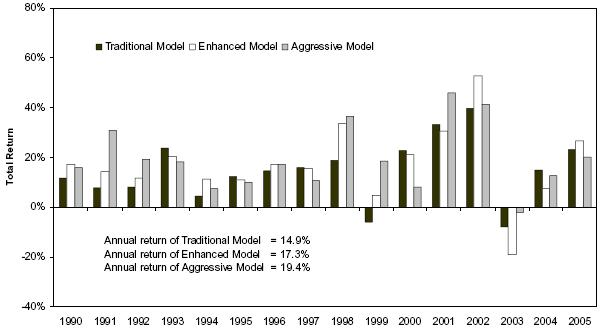Does a natural selection metaphor apply to stock picking models? In other words, can competition among a large set of dynamic models to mimic historical stock performance data evolve the most fit models? In their May 2006 paper entitled “Stock Selection – An Innovative Application of Genetic Programming Methodology”, Ying Becker, Peng Fei and Anna Lester address these questions by applying genetic programming to stock picking. Genetic programming enables the testing of a wide range of stock performance indicators in linear, non-linear and non-obvious combinations. The authors choose the S&P 500, excluding financials and utilities, as their universe of stocks and define two distinct types of stock-picking model fitness: (1) risk-adjusted outperformance compared to a traditional stock-picking model; and, (2) highest possible return independent of risk. They construct for comparison a traditional stock return forecasting model based on a linear combination of four composite factors: valuation, quality, analyst expectations and price. They use monthly data (65 variables for each of about 350 stocks) over the period January 1990 through December 2005 to create environments for model development and out-of-sample testing. They show that:
- Genetic programming can evolve a stock picking model (enhanced model) that supports risk-adjusted outperformance compared to both a market index and a traditional stock-picking model.
- Genetic programming can identify stocks with extreme future returns (aggressive model). This model, in fact, outperforms other models considered on a risk-adjusted basis. This result confirms the importance of non-linear relationships between indicators and stock returns.
- Models developed with genetic programming are more adaptable to changing market conditions (win more consistently) than the traditional model.
The following chart, taken from the paper, shows the performance of the traditional model, the genetic programming enhanced model and the genetic programming aggressive model over the entire 16-year period. The portfolio for each model is long the top quintile of stocks and short the bottom quintile of stocks. All three models outperform a capitalization-weighted index of all stocks considered. Results show that use of genetic programming to develop stock-picking models supports outperformance of a traditional modeling approach.

The paper includes a brief overview of genetic programming methodology, which is not mechanical. The authors “used investment intuition throughout the process and chose the initial factors carefully.” They further note that “the application of genetic programming in a stock selection context is as much an art as a science.”
In summary, knowledgeable humans applying sophisticated programming techniques may be able to beat the market.
One thing this paper reinforces is that individual stock-picking investors are competing with very sophisticated, well-funded institutional “quants” (quantitative financial analysts) for excess returns.